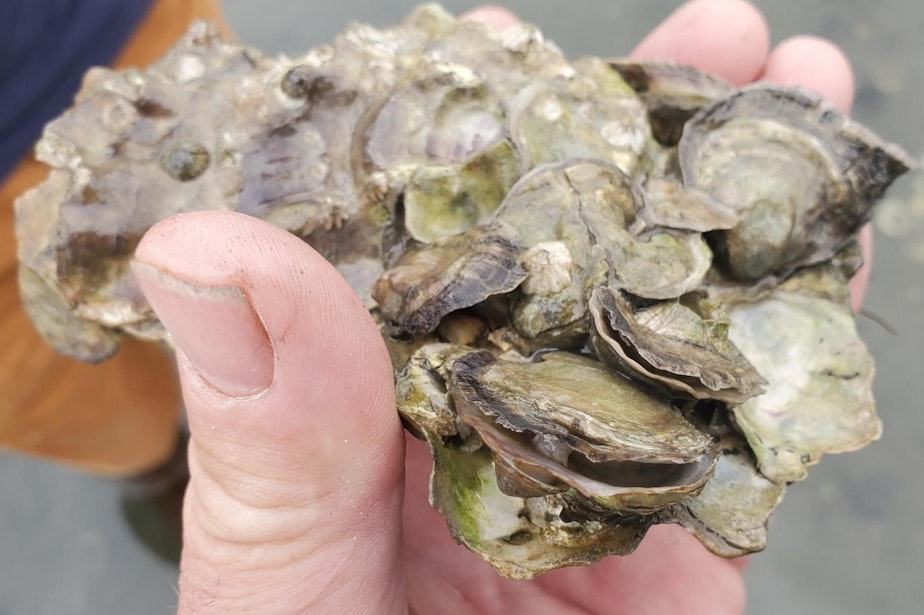Shellfish farmers line up for disaster aid after heat wave decimates oysters and clams

Sixty shellfish farms in Washington state have applied for federal disaster aid after a double whammy of extreme heat and afternoon low tides killed most of their oysters and clams in June.
They’re bracing for a second heat wave this week.
Many shellfish operations in south Puget Sound and Hood Canal reported losing the majority of of their saltwater livestock during the June heat wave, according to Travis Martin with the U.S. Department of Agriculture’s Farm Service Agency.
“From the site visits completed so far, the highest mortality has been 95-99%, mostly in the southern inlets of Puget Sound near Shelton (Hammersley, Oakland Bay, Totten, Little Skookum),” Martin said in an email.
“We definitely had regions of our beaches where we lost 90% of our shellfish,” said shellfish grower John Adams of Sound Fresh Clams and Oysters. “Everything that was in the higher level of the beach is dead, is gone.”
Adams says his farm, located on Little Skookum Inlet outside of Olympia, lost at least 30,000 animals.
Sponsored
What shellfish farmers learned from the last heat wave
Other shellfish farms suffered little damage. Scientists are still sorting out why some areas fared worse than others.
“Some areas are doing okay, some got hit hard and others moderately. Lots swirling as to why the spottiness,” biologist Teri King with Washington Sea Grant said.
Washington state is the nation’s biggest producer of farmed clams, oysters and geoducks, with more than $100 million in annual harvests.
“We got pretty lucky here on the coast,” said David Beugli with the Willapa-Grays Harbor Oyster Growers Association.
On Willapa Bay and Grays Harbor, the low tides came mid-morning, exposing shellfish to the air well before temperatures reached their afternoon peaks.
Sponsored
Shellfish farmer and breeder Joth Davis says his farm, near the mouth of Hood Canal, also got lucky.
A well-timed north wind kept his oysters from baking in the mud. Davis’s crew also spread bedsheets over the oyster beds to keep the animals damp and shaded.
Other shellfish farmers reported moving animals to deeper water, harvesting them in advance of the heat and using garden sprinklers to tamp down the soaring temperatures of exposed shellfish beds.
Davis says he’s optimistic that Washington’s shellfish industry can adapt to a changing climate.
“You have to be an optimist to be a shellfish farmer. You just have to be," he said. "I can't dwell on doom and gloom, though I will say, of course, the trends are not good. But there are also tools in the quiver that we can use.”
Sponsored
Davis is the head of Pacific Hybreed, a company that aims to breed shellfish more resilient to heat, acidification, and diseases – in short, all the hazards that an ocean altered by climate change presents to aquaculture.
Davis says his optimism relies on humanity being able to stop adding heat-trapping carbon pollution to the sky.
“Just decarbonize,” he said. “That is at the end of the day the fundamental cause and the first-line solution. It's not going to be easy, and no one's saying it is, but we just have to do it.”
Other farmers wonder how long the solutions they're using to combat rising temperatures can last.
“People, small businesses, are only so resilient,” shellfish farmer John Adams said. “As a society, we need to be mindful we don’t give ourselves too much work to do with this climate change.”
Sponsored
More trouble for sea life could be ahead
On Wednesday, the National Weather Service issued an excessive heat warning for most of western Washington, with temperatures expected to hit the lower 90s on Wednesday and approach 100 degrees on Thursday and Friday.
As with the June heat wave, the highest temperatures and lowest tides are expected to coincide in the afternoons for much of Puget Sound, a deadly combination for creatures living on tideflats.
“It’s not just shellfish,” Adams said. “The whole beach habitat has been stressed by this. If you degrade one part of the system it sends shimmers through the rest of the food web.”
Adams described crabs trying in vain to fend off the lethal heat.
"You can see them swinging their claws at their head areas trying to get whatever’s attacking them," he said.
University of British Columbia biologist Chris Harley estimated that billions of mussels and barnacles died on the tidelands of Washington and British Columbia during June’s extreme heat.
Sponsored
"Who knows how many little crustaceans, worms, and other wee beasts were lost," Harley said in an email.
UBC student Lara Calvo documented a common type of seaweed, known as Fucus or bladder wrack, disappearing from shorelines near Vancouver around the time of June's record-shattering heat.
"This seaweed provides protection (from heat and desiccation) and habitat for intertidal organisms," Calvo said in an email. "Thus losing chunks of a Fucus bed is very worrying."
One bit of good news for sea life this time: This week’s afternoon low tides are expected to be one to five feet higher than those during the June heat wave, leaving more intertidal life covered by cooling seawater and less of it exposed to extremely overheated air.




